See also the Urban Stream tab for research on stormwater control and stream health.
Scientists and engineers at Temple are researching urban runoff along I-95 during and after storms, the accumulation of road salt and other contaminants, and the performance of plants in this dynamic environment. Successfully managing stormwater on highways can reduce flooding, limit urban runoff to streams, and mitigate urban heat island impacts. Our team has a grant from AECOM, an engineering firm that is managing reconstruction on I-95 through Philadelphia for the Pennsylvania Department of Transportation (PennDOT).
Temple University has a number of stormwater control measures on campus, and the past project evaluated how they are working. The campus stormwater projects are part of the Philadelphia Green Streets program to reduce stormflow to combined sewer outfalls.
CURRENT FUNDING:
PennDOT though an IDEA grant (2016-17) and through subcontracts from AECOM (2016-present) $3.7 Million. Collaborators in the Department of Landscape Architecture and the College of Civil and Environmental Engineering, along with Villanova University
PAST FUNDING:
Pennsylvania Sea Grant 2019-2021. Stormwater Nitrogen Management, with Erica McKenzie, College of Engineering.
Environmental Protection Agency (2014-2018) Performance and Effectiveness of Green Infrastructure Stormwater Management Approaches in the Urban Context: A Philadelphia Case Study. Collaborators include Villanova University and Temple Facilities.
 Downloading data Downloading data |
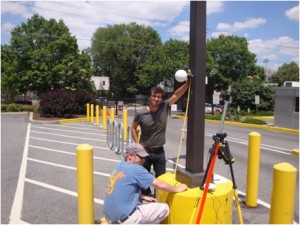 LiDAR survey Lot 10 LiDAR survey Lot 10 |
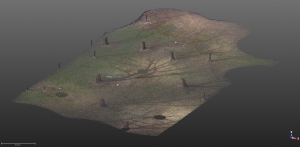 3D LiDAR plot (trees trimmed) 3D LiDAR plot (trees trimmed) |
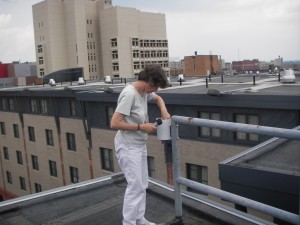 Rain gauge Rain gauge |
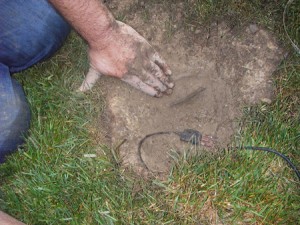 Soil moisture probe Soil moisture probe |
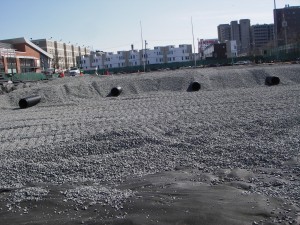 Stormwater retention chamber Stormwater retention chamber |
PUBLICATIONS:
Pope, G. G., Toran, L., Caplan, J. S., & Nyquist, J. (2025). Spatiotemporal Dynamics of Road Salt in a Highway Bioswale: A Comparison of Point and Continuous Monitoring Methods. Water, Air, & Soil Pollution, 236(10), 1-19.
Kirker, A. N., Cushman, E., & Toran, L., 2024. Disconnect between Capture Areas and Stormwater Runoff: A Pre-and Postinstallation Model of Two Stormwater Control Measures. Journal of Sustainable Water in the Built Environment, 10(3), 04024006.
Kirker, A.N. and Toran, L., 2023. When impervious cover doesn’t predict urban runoff: Lessons from distributed overland flow modeling. Journal of Hydrology, 621, p.129539. DOI: 10.1016/j.jhydrol.2023.129539
Donaghue, A.G., Morgan, N., Toran, L, and McKenzie, E.R., 2023. In situ monitoring of internal water storage reveals nitrogen first flush phenomena, intermittent denitrification, and seasonal ammonium flushing. Journal of Environmental Management, 341: 117957. doi.org/10.1016/j.jenvman.2023.117957
Pope, G.G., Nyquist, J.E., and Toran, L. 2022. Time lapse resistivity monitoring of a simulated runoff test in a bioswale located in Philadelphia, PA. Journal of Sustainable Water in the Built Environment. 9(1): 04022018
Donaghue, A.G. ,Morgan, N., Toran, L, and McKenzie, E.R., 2022. The impact of bioretention column internal water storage underdrain height on denitrification under continuous and transient flow. Water Research, 214: 118205. https://doi.org/10.1016/j.watres.2022.118205
Toran, L; Eisenman, S; Caplan, J; van Aken, B; McKenzie, E; Nyquist, J; Ryan, R; Kelley, J; Traver, R, Tu, M; Schmidt, N; Calt. 2017. Stormwate control management and monitoring. Final Report for PennDOT IDEA grant TEM 006. See researchgate for full report. Executive summary pdf [Winner of American Association of State Highway and Transportation Officials High Value Research Award]
Toran, L. 2016. Water level loggers as a low-cost tool for monitoring of stormwater control measures. Water. 8, 346; doi:10.3390/w8080346 (10 pp) pdf
THESES:
Kyle Collins, 2020. Geophysical, hydrologic, and sedimentological analysis for assessing sediment accumulation and infiltration rates in urban stormwater basins.
Naomi Morgan, 2020. Dual isotope analysis of denitrification in stormwater basins.
Vince Carsillo, 2018. Monitoring Stormwater Infiltration in a Vacant Lot Comparing Time-Lapse Electromagnetic Induction and Electrical Resistivity Tomography
Paul Zarella, 2016. Using geophysics and terrestrial LiDAR to asses stormwater parameters in vacant lots in Philadelphia.
